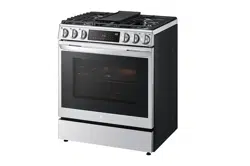Documents: Go to download!
User Manual
- Owner's manual - (English)
- User Guide - (English)

OWNER'S MANUAL RANGE
PRODUCT OVERVIEW
Exterior & Interior

- Cooktop
- Cooktop controller
- Oven door
- Storage drawer
- Oven mode knob
- Gasket
- Broil heater
- Convection heater
- Model & serial number plate
Product Specifications
The appearance and specifications listed in this manual may vary due to constant product improvements.

Accessories
Included Accessories
Anti-tip Kit

- Anti-tip bracket (1ea)
- Screws (6ea)
- Anchors (6ea)
- Template (1ea)
LP Nozzle Conversion Kit

- Cooktop nozzles (6ea)
- Installation guide (1ea)
Other Accessories

- Heavy duty rack (2ea)
- Griddle (1ea)
- Rear filler (1ea)
- Air fry tray (1ea)
- Meat probe (1ea)
- Owner’s manual (1ea)
- Spray bottle (1ea)
- Non-scratch scouring pad (1ea)
Optional Accessories

- Grid
- Broiler pan
INSTALLATION
Before Installing
Installation Overview
Please read the following installation instructions first after purchasing this product or transporting it to another location. The images in this guide may be different from the actual components and accessories, which are subject to change by the manufacturer without prior notice for product improvement purposes.
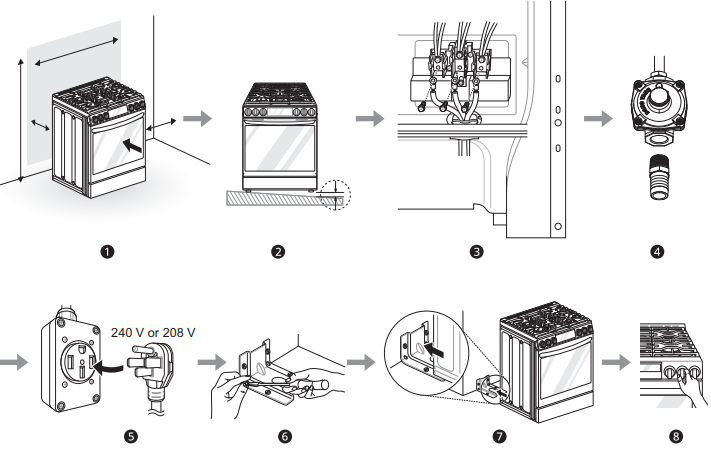
- Check and choose the proper location
- Level the range
- Connect electric range
- Connect the range to gas
- Plug in the power cord
- Install anti-tip device
- Engage the anti-tip device
- Test run
Tools Needed
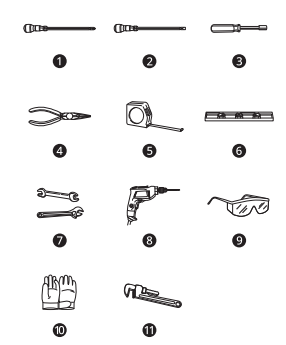
- Phillips screwdriver
- Flat-blade screwdriver
- 1/4" nut driver
- Pliers
- Tape measure
- Level
- Adjustable wrench
- Drill
- Safety glasses
- Gloves
- Pipe wrench (2ea, one for support)
Parts
Parts Provided

- Template (1)
- Anti-tip bracket kit (1)
- Anchor sleeves (6)
- Lag bolts (6)
Parts Not Provided

- 4-Wire cord or 3-Wire cord (UL approved 40 or 50 AMP)
- Strain relief (for conduit installations only)
Parts You May Need
- Gas line shut-off valve ï Pipe joint sealant that resists action of natural and LP gases
- Flexible metal appliance connector (3/4" or 1/2" NPT x 1/2" I.D.)
- Never use an old connector when installing a new range.
- Flare union adapter for connection to gas supply line (3/4" or 1/2" NPT x 1/2" I.D.)
- Flare union adapter for connection to pressure regulator on range (1/2" NPT x 1/2" I.D.)
- Liquid leak detector or soapy water
- Lag bolt or 1/2" O.D. sleeve anchor (for concrete floors only)
NOTE
- Observe all governing codes and ordinances.
- Have the installer show you the location of the circuit breaker or fuse. Mark it for easy reference.
- As when using any appliance generating heat, there are certain safety precautions you should follow.
- Be sure your range is installed and grounded properly by a qualified installer or service technician.
In the Commonwealth of Massachusetts
- This product must be installed by a licensed plumber or gas fitter
- When using ball type gas shut-off valves, they must be the T-handle type.
- When using a flexible gas connector, it must not exceed 3 feet in length.
Unpacking and Moving the Range
WARNING
- You should use two or more people to move and install the range. (Excessive Weight Hazard) Failure to do so can result in back or other injury.
- Do not use the door handle to push or pull the range during installation or when moving the range out for cleaning or service. Doing so can result in serious damage to the door of the range. ï To reduce the risk of burns, do not move this appliance while it is hot.
NOTE
- Your range is heavy and can be installed on soft floor coverings such as cushioned vinyl or carpeting. Use care when moving the range on this type of flooring. Use a belt when moving the range to prevent damaging the floor. Or slide the range onto cardboard or plywood to avoid damaging the floor covering.
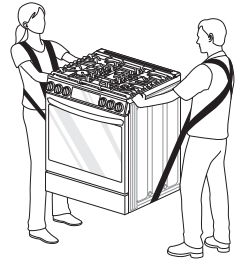
- Remove packing material, tape and any temporary labels from your range before using. Do not remove any warning-type labels, the model and serial number label, or the Tech Sheet that is located on the back of the range.
- To remove any remaining tape or glue, rub the area briskly with your thumb. Tape or glue residue can also be easily removed by rubbing a small amount of liquid dish soap over the adhesive with your fingers. Wipe with warm water and dry.
- Do not use sharp instruments, rubbing alcohol, flammable fluids, or abrasive cleaners to remove tape or glue. These products can damage the surface of your range.
Choosing the Proper Location
Ventilation
- Avoid placing cabinets above the range. To minimize the hazard caused by reaching over the open flames of operating burners, install a ventilation hood over the range that projects forward at least five inches beyond the front of the cabinets.
- Do not locate your range where it may be subject to strong drafts. Any openings in the floor or wall behind the range should be sealed. Make sure the openings around the base of the range that supply fresh air for combustion and ventilation are not blocked by carpeting or woodwork.
- This appliance must not be installed with a ventilation system that blows air downward toward the range. This type of ventilation system may cause ignition and combustion problems with the gas cooking appliance resulting in personal injury or unintended operation.
Electricity
CAUTION: This range is for indoor, household use only. Do not install the range in areas exposed to the weather and/or water.
The range should always be plugged into its own individual properly grounded electrical outlet.
- This prevents overloading house wiring circuits which could cause a fire hazard from overheated wires.
- It is recommended that a separate circuit serving only this appliance be provided.
Flooring
- CAUTION: Use an insulated pad or 1/4 in. (0.64 cm) plywood under the range if installing the range over carpeting.
- When the floor covering ends at the front of the range, the area that the range will be installed on should be built up with plywood to the same level or higher than the floor covering. This will allow the range to be moved for cleaning and servicing, as well as provide proper air flow to the range.
Ambient Temperature
- CAUTION: Make sure wall coverings, countertops and cabinets around the range can withstand the heat (up to 194 °F) generated by the range. Discoloration, delamination or melting may occur. This range has been designed to comply with the maximum allowable wood cabinet temperature of 194 °F.
- Before installing the range in an area covered with linoleum or other synthetic floor covering, make sure the floor covering can withstand temperatures of at least 160 °F (70 °C).
Dimensions and Clearances
- Provide proper clearance between the range and adjacent combustible surfaces.
- These dimensions must be met for safe use of your range.
- The location of the electrical outlet and pipe opening (see "Gas Pipe and Electrical Outlet Locations" below) may be adjusted to meet specific requirements.
- The range may be placed with 0" clearance (flush) at the back wall.
Dimensions
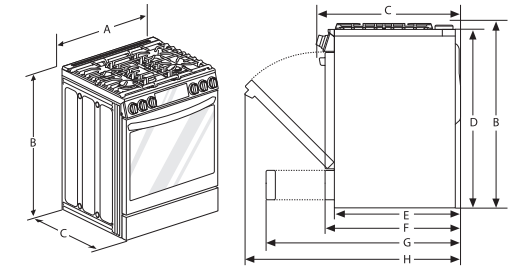

Clearances
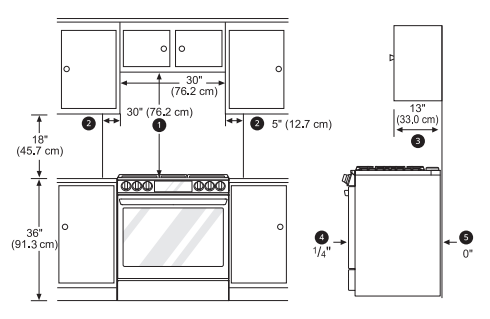
- Minimum
- Minimum clearance to left/right wall
- Maximum depth for cabinets above countertops
- Front edge of the range side panel forward from cabinet
- To cabinets below cooktop and at the range back
Gas Pipe and Electrical Outlet Locations

- Acceptable electrical outlet area
- Normal counter top depth
- Counter top height
- Cabinet
- Wall
- Center: A (Cabinet opening)
= 30" (76.2 cm) For U.S.A
= 30" (76.2 cm) ~ 31" (78.7 cm) For CANADA
Leveling
Leveling the Range
Level the range by adjusting the leveling legs with a wrench. Extending the legs slightly may also make it easier to insert the rear leg into the anti-tip bracket.

Checking Adjustments
- Place the level diagonally on the oven rack, and check each direction for level. First check direction 1. Then check direction 2.

- If the level doesn’t show that the rack is level, adjust the leveling legs with a wrench.
Connecting Gas
Providing Adequate Gas Supply
- Your range is designed to operate at a pressure of 5" of water column on natural gas or 10" of water column on LP.
- Make sure you are supplying your range with the type of gas for which it is configured.
- This range is convertible for use with natural or LP gas. When using this range with LP gas, conversion must be made by a qualified LP installer before attempting to operate the range.
- For proper operation, the pressure of natural gas supplied to the regulator must be between 5" and 13" of water column.
- For LP gas, the pressure supplied to the regulator must be between 10" and 13" of water column. When checking for correct operation of the regulator, the inlet pressure must be at least 1" more than the operating (manifold) pressure as given above.
- The pressure regulator located at the inlet of the range must remain in the supply line regardless of which type of gas is being used.
- A flexible metal appliance connector used to connect the range to the gas supply line should have an I.D. of 5/8" and a maximum length of 5 feet. In Canada, flexible connectors must be single wall metal connectors less than 6 feet in length.
Connecting the Range to Gas
WARNING
- Isolate the range from the gas supply system by closing its individual shut-off valve during any pressure testing of the gas supply system at test pressures equal to or less than 1/2 psi (3.5 kPa)
- The appliance and its individual shut-off valve must be disconnected from the gas supply piping system during any pressure testing of that system at test pressures in excess of 1/2 psi (3.5 kPa).
Shut off the range gas supply valve before removing the old range and leave it off until the new hook-up has been completed.
Because hard piping restricts movement of the range, the use of a CSA International-certified flexible metal appliance connector should be used unless local codes require a hard-piped connection.
A manual valve shall be installed in an accessible location in the gas piping external to the appliance for the purpose of turning on or shutting off gas to the appliance.
Never reuse an old connector when installing a new range. ï To protect against gas leaks, use a qualified pipe joint sealant on all external threads.
- Install a male 1/2" or 3/4" flare union adapter to the NPT internal thread of the manual shutoff valve, taking care to back-up the shut-off valve to keep it from turning.
- Install a male 1/2" flare union adapter to the 1/2" NPT internal thread at the inlet of the pressure regulator. Use a backup wrench on the pressure regulator fitting to prevent damage.
- Connect a flexible metal appliance connector to the adapter on the range. Position the range to permit connection at the shut-off valve.
- When all connections have been made, be sure all range controls are in the OFF position before turning on the main gas supply valve. ï Gas leaks may occur in your system and create a hazard. Gas leaks may not be detected by smell alone.
- Check all gas connection joints and fittings for leaks with a non-corrosive leak detection fluid, then wipe off. Gas suppliers recommend you purchase and install a UL approved gas detector. Install and use in accordance with the installation instructions.
Flexible Connector Hookup
Have the installer show you the location of the range gas shut-off valve and how to shut it off if necessary.

- Pressure regulator
- 1/2" adapter
- 1/2" adapter
- Gas flow into range
- Flex connector (6 ft. max.)
- Gas shut-off valve
- 1/2" adapter
- 1/2" or 3/4" gas pipe
Pressure Regulator Position

- Pressure regulator
Connecting Electricity
Electrical Requirements
This appliance must be installed and grounded on a branch circuit by a qualified technician in accordance with the National Electrical code ANSI/ NFPA NO. 70 - latest edition.
All wiring should conform to Local and NEC codes. This range requires a single-phase, 3 wire, AC 120/ 208 V or 120/240 V 60 Hz electrical system. Use only a 3-conductor or a 4-conductor UL - listed range cord with closed-loop terminals, open-end spade lugs with upturned ends or similar termination. Do not install the power cord without a strain relief.
A range cord rated at 40 amps with 120/240 minimum volt range is required. If a 50 amp range cord is used, it should be marked for use with 13/ 8" diameter connection openings. This appliance may be connected by means of a conduit or power cord. If a conduit is being used, refer to "3-Wire Connection: Conduit" or "4-Wire Connection: Conduit" sections.
WARNING
- Allow 2 to 3 ft (61.0 cm to 91.4 cm) of slack in the line so that the range can be moved if servicing is ever necessary.
- The power supply cord and plug should not be modified. If it will not fit the outlet, have a proper outlet installed by a qualified electrician.
- Using an extension cord to connect the power is prohibited. Connect the power cord and plug directly.
- Electrical ground is required on this appliance.
- Make sure that the power cord is not pinched by the range or heavy objects. Failure to do so can result in serious burns or electrical shock.
NOTE
- If an external electrical source is utilized, the appliance, when installed, must be electrically grounded in accordance with local codes or, in the absence of local codes, with the National Electrical Code, NFPA70 or the Canadian Electric Code, CSA C22.1-02.
Connecting the Power Cord / Conduit
The rear access cover 1 must be removed. Loosen the two screws with a screwdriver. The terminal block will then be accessible.

Use the cord/conduit connection plate 2 to install the power cord or conduit. Leave the connection plate as installed for power cord installations. Remove the connection plate for conduit installations and rotate it to use the smaller 1 1/8 in. (2.8 cm) conduit hole 3 instead of the 1 3/8 in. (3.5 cm) power cord hole 4.
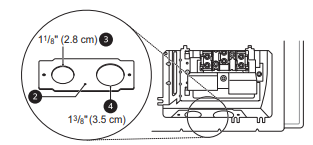
For power cord 5 installations, hook the strain relief over the 1 3/8 in. (3.5 cm) power cord hole located below the rear of the oven. Insert the power cord through the strain relief and tighten it.
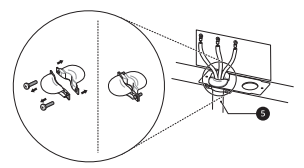
For conduit installations, insert the conduit strain relief in the 1 1/8 in. (2.8 cm) conduit hole. Then install the conduit through the body of the strain relief and fasten the strain relief with its ring.
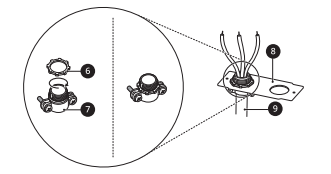
6. Ring
7. Body
8. Cord/Conduit connection plate
9. Conduit
3-Wire Connection: Power Cord
WARNING
- The white middle (neutral or ground) wire of a 3- wire power cord or a 3-wire conduit has to be connected to the middle post of the main terminal block. The remaining two wires of the power cord or conduit have to be connected to the outside posts of the main terminal connection block. Failure to do so can result in electrical shock, severe personal injury or death.
- If screws are not tightened securely, it can result in electrical spark and severe personal injury or death.
- For power cord installations, hook the strain relief over the power cord hole (1 3/8") located below the rear of the oven.
- Insert the power cord through the strain relief and tighten it.
- Remove the lower 3 screws from the terminal block and retain them.
- Insert the 3 screws through each power cord terminal ring and into the lower terminals of the terminal block. Make sure that the white center wire is connected to the center lower position of the terminal block.
- Tighten the 3 screws securely into the terminal block.
CAUTION: Do not remove the ground strap connections

- Black
- White
- Red
- Terminal block
- Cord/Conduit connection plate
4-Wire Connection: Power Cord
WARNING
- Only a 4-conductor power-supply cord kit rated 120/240 volts, 50 amperes and marked for use with ranges with closed-loop connectors or opened spade lugs with upturned ends must be used. The white middle (neutral) wire of the power cord or 4-wire conduit has to be connected to the middle post of the main terminal block. The other two wires of the power cord or conduit have to be connected to the outside posts of the main terminal connection block. The 4th ground wire (green) must be connected to the frame of the range with the ground screw. Failure to do so can result in electrical shock, severe personal injury or death.
- If screws are not tightened securely, it can result in electrical spark and severe personal injury or death.
- For power cord installations, hook the strain relief over the power cord hole (1 3/8") located below the rear of the oven.
- Insert the power cord through the strain relief and tighten it.
- Remove the lower 3 screws from the terminal block and retain them.
- Remove the ground screw and bend the end of the ground strap up so the slot is over the hole of the center screw removed in step 3.
- Insert the ground screw into the power cord ground wire (green) terminal ring and secure it to the range frame.
- Insert the 3 screws through each power cord terminal ring and into the lower terminals of the terminal block. Make sure that the white center (neutral) wire is connected to the center lower position of the terminal block.
- Tighten the 3 screws securely into the terminal block. The center screw now attaches the bent up ground strap to the block.

- Black
- White
- Red
- Terminal block
- Ground strap
- Ground screw
- Cord/Conduit connection plate
- Bend strap up and attach.
3-Wire Connection: Conduit
WARNING: If screws are not tightened securely, it can result in electrical spark and severe personal injury or death.
Conduit Installations
- Remove the cord/conduit connection plate from the rear of the oven and rotate it. The conduit hole (1 1/8") must be used.
- Prepare the conduit wires as shown below.
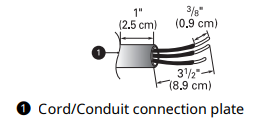
- Install the conduit strain relief. Insert the strain relief in the 1 1/8 in. (2.8 cm) conduit hole. Install the conduit through the body of the strain relief and fasten the strain relief with its ring.
- Reinstall the cord/conduit connection plate.
Conduit Connections - If the wire in the conduit is copper it must be 8 or 10 AWG wiring. If the wire in the conduit is aluminum it must be 6 or 8 AWG wiring.
- Loosen the lower 3 screws from the terminal block.
- Insert the bare wire (white/neutral) end through the center terminal block opening. Do not remove the ground strap connections.
- Insert the two side bare wire ends into the lower left and the lower right terminal block openings.
- Tighten the 3 screws securely into the terminal block. (approximately 35 - 50 IN-LB)
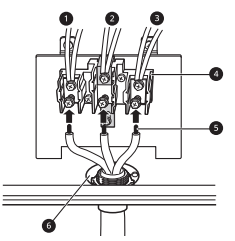
- Black
- White
- Red
- Terminal block
- Wire ends
- Conduit connection plate
4-Wire Connection: Conduit
WARNING
- The white middle (neutral) wire of the power cord or 4-wire conduit has to be connected to the middle post of the main terminal block. The other two wires of the power cord or conduit have to be connected to the outside posts of the main terminal connection block. The 4th ground wire (green) must be connected to the frame of the range with the ground screw. Failure to do so can result in electrical shock, severe personal injury or death.
- If screws are not tightened securely, it can result in electrical spark and severe personal injury or death.
Conduit Installations
- Remove the cord/conduit connection plate from the rear of the oven and rotate it. ï The conduit hole (1 1/8") must be used.
- Prepare the conduit wires as shown below.

- Install the conduit strain relief. Insert the strain relief in the 1 1/8 in. (2.8 cm) conduit hole. Install the conduit through the body of the strain relief and fasten the strain relief with its ring.
- Reinstall the cord/conduit connection plate.
Conduit Connections - If the wire in the conduit is copper it must be 8 or 10 AWG wiring. If the wire in the conduit is aluminum it must be 6 or 8 AWG wiring.
- Loosen the 2 lower left and right screws from the terminal block. Remove the lower 2 center screws. Do not discard any screws.
- Remove the ground screw and bend the end of the ground strap up so the slot is over the hole of the center screw removed in step 1.
- Attach the ground (green) bare wire end to the range frame and secure it in place with the ground screw.
- Insert the bare wire (white/neutral) end through the center terminal block opening. The center screw now attaches the bent up ground strap to the block.
- Insert the two side bare wire ends into the left and the right terminal block openings. Tighten the 3 screws securely into the terminal block. (approximately 35 - 50 IN-LB)

- Black
- White
- Red
- Terminal block
- Wire ends
- Ground strap
- Conduit connection plate
- Ground screw
- Ground wire
- Bend strap up and attach.
Surface Burners
Assembling the Surface Burners
- Place the burner caps and heads on the cooktop. There are one small, one medium, one large, one oval (center), and one extra large burner head and cap.
- Make sure that the caps and heads are placed in the correct locations.
- Make sure the hole in the burner head is positioned over the electrode.

- Oval (center) burner head/cap assembly
- Medium burner head and cap
- Small burner head and cap
- Large burner head and cap
- Front of range
- Dual burner head and cap
- Hole
- Electrode
Checking Ignition of the Surface Burners
Electric Ignition
Select a surface burner knob and simultaneously push in and turn to the Lite position. You will hear a clicking sound indicating proper operation of the spark module.
Once the air has been purged from the supply lines the burner should ignite within 4 seconds. After the burner ignites, rotate the knob out of the Lite position. Try each burner in succession until all burners have been checked.
Quality of Flames
The combustion quality of the burner flames needs to be confirmed visually.
Yellow flames
Call for service. 
Yellow tips on outer cones
This is normal for LP gas. 
Soft blue flames
This is normal for natural gas. 
Adjusting the Surface Burner to the Low Flame (Simmer) Setting
1. Light all surface burners.
2. Turn the knob on the burner being adjusted to Lo.
3. Remove the knob and knob ring.
See other models: LSDL6336D U9CV1C XD4B24UPS A9N-WHITE A9N-TWIN
4. Insert a small, flat-blade screwdriver into the opening marked below.
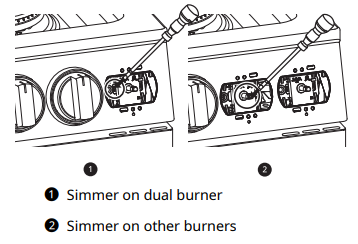
5. Turn the screw to adjust. Hold the valve shaft with one hand while turning the screw to adjust with the other.
6. Replace the knob.
7. Test the flame stability.
- Test 1: Turn the knob from Hi to Lo quickly. If the flame goes out, increase the flame size and test again.
- Test 2: With the burner on a Lo setting, open and close the oven door quickly. If the flame is extinguished by the air currents created by the door movement, increase the flame height and test again.
8. Repeat steps 1-7 for each surface burner
Optional Rear Filler
Installing the Rear Filler
If the counter does not bridge the opening at the rear wall, the rear filler kit which is provided with the slide in range will be needed.
NOTE: If the countertop depth is greater than 25 3/8 " there will be a gap between the filler kit and the back wall.
If the countertop depth is less than 24 3/4 ", the control panel will not sit flush with the countertop.
1. Using a screwdriver, remove the three screws holding the rear top plate in place.
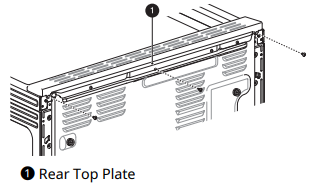
2. Attach the rear top plate and filler assembly as shown, using three screws removed in step 1.
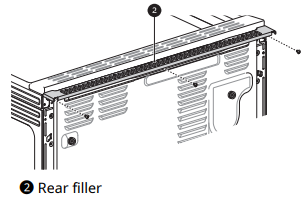
Anti-tip Device
Installing the Anti-tip Device
WARNING
- A child or adult can tip the range and be killed.
- Install the anti-tip device to the structure and/or the range. Verify the anti-tip device has been properly installed and engaged by following the guide on the anti-tip bracket template.
- Engage the range to the anti-tip device by following the guide on the anti-tip bracket template. Ensure the anti-tip device is reengaged when the range is moved by following the guide on the anti-tip bracket template.
- Re-engage the anti-tip device if the range is moved. Do not operate the range without the anti-tip device in place and engaged.
- See installation instructions for details.
- Failure to follow these instructions can result in death or serious burns to children or adults.
- Range must be secured with an approved antitip device.
- The range could be tipped by standing, sitting or leaning on an open door if the range or anti-tip device is not properly installed.
- The use of this device does not preclude tipping of the range when not properly installed.
After installing the anti-tip device, verify that it is in place by carefully attempting to tilt the range forward.
This range has been designed to meet all recognized industry tip standards for all normal conditions.
The installation of the anti-tip device must meet all local codes for securing the appliance.
Using the Anti-Tip Bracket Template
- The anti-tip bracket is packaged with an installation template. The instructions include necessary information to complete the installation. Read and follow the range installation instruction sheet.
- Screws 3 must enter wood or concrete.
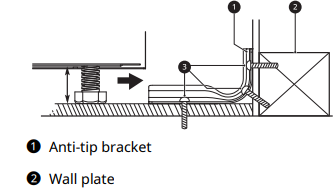
Engaging the Anti-tip Device

- Slide the range against the wall, making sure the back leg slides into and engages the antitip bracket.
- Check for proper installation by grasping the front edge of the cooktop and carefully attempting to tilt the range forward.
Test Run
Test the Range Before Use
NOTE: Do not try to light either the Bake or Broil burners during a power outage. The range has an electrical ignition system and cannot be used without power.
Checking Operation of Bake Burners - To check ignition of the Bake burner, follow the steps below:
- Remove all packing materials from inside the oven cavity.
- Turn oven mode knob to select Bake. 350 °F appears in the display. Make sure the door is closed.
- Press START.
Checking Operation of Broil Burners - To check ignition of the Broil burner, follow the steps below:
- Remove all packing materials from inside the oven cavity.
- Turn oven mode knob to select Broil. Hi appears in the display. Make sure the door is closed.
- Press START.
NOTE: It may take between 30 and 90 seconds for the burner to start heating.
OPERATION
Control Panel
Control Panel Features

- Smart Diagnosis: Use during the Smart Diagnosis feature.
- Control Lock: Press and hold the button for 3 seconds to lock the control panel.
- Cook Time: Press the button to set the desired amount of time for food to cook. The oven shuts off when the set cooking time runs out.
- Start Time: Press the button to set the delayed timed cook. The oven starts at the set time.
- Temp. Press the button to set the oven temperature during oven use.
- Timer On/Off / Wi-Fi: Press the button to set or cancel the oven timer. Press and hold the button for 3 seconds to connect the appliance to a Wi-Fi network.
- Keep Warm: Press the button to keep food warm after cooking. This feature should be used after cooking in the oven.
- Settings: Press the button to select and adjust oven settings.
- Clock: Press the button to set the time of day.
- Light: Press the button to turn the oven light on or off.
- START: Press the button to start all oven features.
- Oven Mode Knob: Turn the knob to select the oven operating mode.
NOTE
- Flashing Clock: If the colon in the clock display flashes, press Clock and reset the time, or press any key to stop the flashing.
- Press any button on the control panel to activate the display.
- Setting the Time, Timer and Temperature: If you enter one digit of a number incorrectly, enter the entire number again to correct it. For example, if you press 1, 0, 3 and 1 to set the clock for 10:30, press 1, 0, 3 and 0 to enter the correct time.
Changing Oven Settings
Clock - The clock must be set to the correct time of day in order for the automatic oven timing functions to work properly.
- Press Clock
- Press the numbers to enter the time. For example, to set the clock for 10:30, press the numbers: 1, 0, 3 and 0.
- Press START.
Oven Light - The interior oven light automatically turns on when the door is opened.
- Press Light to manually turn the oven light on.
Timer On/Off - The Timer serves as an extra timer in the kitchen that beeps when the set time has run out. It does not start or stop cooking. The Timer feature can be used during any of the other oven control functions. For example, to set 5 minutes:
- Press Timer On/Off once. 0:00 appears and Timer flashes in the display.
- Press 5. 0:05 appears in the display.
- Press Timer On/Off to start the Timer. The remaining time countdown appears in the display. If Timer On/Off is not pressed, the timer returns to the time of day.
- When the set time runs out, End shows in the display. The indicator tones sound every 15 seconds until Timer On/Off is pressed.
Canceling the Timer
- Press Timer On/Off once. The display returns to the time of day.
Wi-Fi - The Wi-Fi button is used to connect the appliance to a home Wi-Fi network.
- Set the oven mode knob to the OFF position.
- Press and hold Timer On/Off for 3 seconds.
- The power on chime sounds, SEt appears in the display, and the Wi-Fi icon (f) blinks.
- Connect the appliance to the Wi-Fi network using the LG ThinQ smartphone app.
- To disconnect the appliance from the network, delete it from the connected appliances in the app.
Settings (Hour Mode, Convection Auto Conversion, Oven Thermostat, Preheat Alarm Light, Beeper Volume, Fahrenheit or Celsius) - Press the Settings button repeatedly to toggle through and change oven settings. The Settings button allows you to:
- set the hour mode on the clock (12 or 24 hours)
- enable/disable convection auto conversion
- adjust the oven thermostat
- activate/deactivate the preheating alarm light ï
- set the beeper volume
- switch the temperature scale between Fahrenheit and Celsius
Setting the Hour Mode - The control is set to use a 12-hour clock. To reset the clock to 24-hour mode, follow the steps below.
- Press Settings once.
- Press 1 to toggle between a 12-hour and 24- hour clock.
- Press START to accept the change.
Setting Convection Auto Conversion - When Conv. Bake and Conv. Roast are selected, Convection Auto Conversion automatically converts the standard recipe temperature entered to a convection temperature by subtracting 25 ℉ / 14 ℃. This auto converted temperature shows on the display. For example, select Conv. Bake, enter 350 ℉, and 325 ℉ shows on the display after preheat. Convection Auto Conversion is enabled by default. To change the setting, follow these instructions.
- Press Settings repeatedly until Auto appears in the display.
- Press 1 to disable or enable auto conversion.
- Press START to accept the change.
Adjusting the Oven Thermostat - Your new oven may cook differently from the one it replaced. Use your new oven for a few weeks to become more familiar with it before changing the temperature settings. If after familiarizing yourself with the new oven, you still think that it is too hot or too cold, you can adjust the oven thermostat yourself. To begin, either raise or lower the thermostat 15℉ (8 ℃). Try the oven with the new setting. If the oven still needs adjustment, raise or lower the thermostat again, using the first adjustment as a gauge. For example, if the adjustment was too much, raise or lower the thermostat 10 ℉ (5 ℃). If the adjustment was not enough, raise or lower the thermostat 20 ℉ (12 ℃). Proceed in this way until the oven is adjusted to your satisfaction.
- Press Settings repeatedly until AdJU appears in the display.
- Use the number buttons to enter the number of degrees you want to adjust the oven temperature.
- Adjust the temperature either up or down by pressing Settings repeatedly to toggle between plus (+) or minus (-).
- Press START to accept the change.
Turning the Preheat Alarm Light On/Off - When the oven reaches its set-temperature, the preheating alarm light flashes 5 times or until the oven door is opened. You can activate or deactivate the preheating alarm light.
- Press Settings repeatedly until PrE appears in the display.
- Press 1 to turn the light on/off.
- Press START to accept the change.
Adjusting the Beeper Volume
- Press Settings repeatedly until Beep appears in the display.
- Press 1 to select Hi, Lo or Off.
- Press START to accept the change.
Selecting Fahrenheit or Celsius - Set the oven temperature display to show either Fahrenheit (℉) or Celsius (℃) units. The oven defaults to Fahrenheit unless changed by the user.
- Press Settings repeatedly until Unit appears in the display.
- Press 1 to select F (Fahrenheit) or C (Celsius).
- Press START to accept the change.
Control Lock - The Control Lock feature locks the control panel and oven mode knob. When the Control Lock feature is activated, the cooktop still functions, but the oven mode knob does not.
- Press and hold Control Lock for three seconds.
- The lock melody sounds. Loc and the lock icon
 appear in the display.
appear in the display. - To deactivate the Control Lock feature, press and hold Control Lock for three seconds. The unlock melody sounds and the controls unlock.
Start Time (Delayed Timed Cook) - The automatic timer of the Delayed Timed Cook function turns the oven on and off at the time you select. This feature can be used with the Bake, Conv. Bake and Conv. Roast modes.
Setting a Delayed Timed Cook - For example, to bake at 300 °F and delay the start of baking until 4:30, first set the clock for the correct time of day.
- Turn the oven mode knob to select Bake. 350 °F appears in the display.
- Set the temperature: Press 3, 0 and 0.
- Press Cook Time and touch the number buttons to set the baking time.
- Press Start Time.
- Set the start time: Press 4, 3 and 0 for 4:30.
- Press START. A short beep sounds and Timed Delay and the start time appear in the display. The oven begins baking at the set start time.
The oven will continue to cook for the set amount of time and then turn off automatically. When the cooking time has elapsed:
- End and the time of day show in the display.
- The cook end indicator tone sounds every 60 seconds until the oven mode knob is turned to the OFF position.
Cook Time (Timed Cook) - Set the oven to cook for a specific length of time using the Timed Cook feature. This feature can only be used with the Bake, Conv. Bake, Conv. Roast, Air Sous-Vide, Air Fry, Slow Cook, Frozen Meal and Proof modes.
Setting a Timed Cook - For example, to bake at 300 °F for 30 minutes, first set the clock to the correct time of day.
- Turn the oven mode knob to select Bake. 350 °F appears in the display.
- Set the temperature. Press 3, 0 and 0.
- Press Cook Time. Timed flashes in the display. Bake, 0:00 and 300 °F appear in the display.
- Set the baking time: Press 3 and 0 (for 30 minutes). The baking time can be set for any amount of time between 1 minute and 11 hours and 59 minutes
- Press START.
The oven will continue to cook for the set amount of time and then turn off automatically. When the cooking time has elapsed:
- End and the time of day show in the display.
- The cook end indicator tone sounds every 60 seconds until the oven mode knob is turned to the OFF position.
Changing the Cook Time during Cooking - For example, to change the cook time to 1 hour and 30 minutes during cooking:
- Press Cook Time.
- Change the baking time: Press 1, 3, 0.
- Press START to accept the change.
Minimum & Maximum Default Settings
All of the features listed have a minimum and a maximum time or temperature setting that may be entered into the control. An entry acceptance beep sounds each time a control button is pressed. An entry error tone (two short tones) sounds if the entry of the temperature or time is below the minimum or above the maximum setting for the feature.
† This feature is only available on some models.
* Temperature if using auto conversion
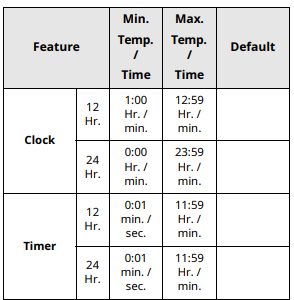
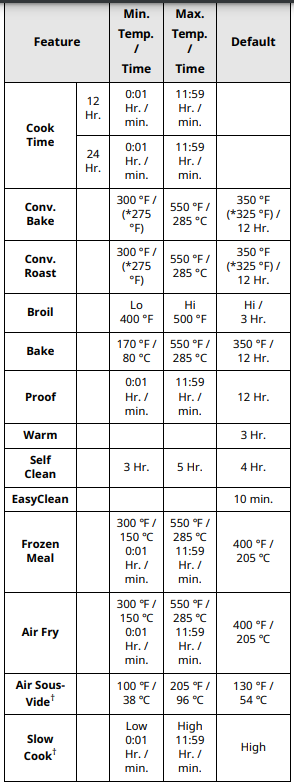
Gas Surface Burners
Before Using the Gas Surface Burners
- Make sure that all burners are properly placed.
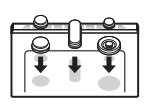
- Make sure that all grates are properly placed before using the burners.
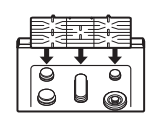
- Make sure that the burners and grates are cool before touching them or placing a pot holder, cleaning cloth, or other materials on them.

Burner Locations - Your gas range cooktop has four or five sealed gas burners, depending on the model. The heads and caps can be assembled and removed for cleaning. Follow the guide below.

- Medium and large burners: The medium and large burners are the primary burners for most cooking. These general purpose burners can be turned down from Hi to Lo to suit a wide range of cooking needs.
- Small burner: The smallest burner is used for delicate foods such as sauces or foods that require low heat for a long cooking time.
- Dual burner (Extra large burner): The dual burner is the maximum output burner. Like the other four burners, it can be turned down from Hi to Lo for a wide range of cooking applications. This burner is also designed to quickly bring large amounts of liquid to a boil. It can be used with cookware 10 inches or larger in diameter.
- Oval burner: The center, oval burner is for use with a griddle or oval pots.
Using the Gas Surface Burners
CAUTION: Match the size of the cooktop burner or element to the size of the cookware in use. Using a large element for a small pan wastes heating energy, and the exposed surface of the element is a burn or fire hazard.
- Be sure that all of the surface burners and grates are placed in the correct positions.
- Place cookware on the grate.
- Push the control knob in and turn to the LITE position to light the burner.
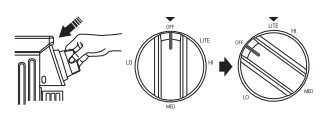
- Turn the control knob to control the flame size.

Setting the Flame Size
Watch the flame, not the knob, as you reduce heat. Match the flame size on a gas burner to the cookware being used for fastest heating.
CAUTION: Never let the flames extend up the sides of the cookware.
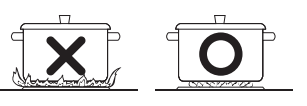
NOTE: The flames on the surface burners may burn yellow in the presence of high humidity, such as a rainy day or a nearby humidifier. After LP gas conversion, flames can be bigger than normal when you put a pot on the surface burner.
Using the Proper Cookware
- Aluminum - Medium-weight cookware is recommended because it heats quickly and evenly. Most foods brown evenly in an aluminum skillet. Use saucepans with tight fitting lids when cooking with minimum amounts of water.
- Cast-Iron - If heated slowly, most skillets will give satisfactory results.
- Stainless Steel - This metal alone has poor heating properties and is usually combined with copper, aluminum or other metals for improved heat distribution. Combination metal skillets work satisfactorily if they are used with medium heat as the manufacturer recommends.
- Enamelware - Under some conditions, the enamel of this cookware may melt. Follow cookware manufacturer’s recommendations for cooking methods.
- Glass - There are two types of glass cookware, those for oven use only and those for top-of-range cooking.
- Heatproof Glass Ceramic - Can be used for either surface or oven cooking. It conducts heat very slowly and cools very slowly. Check cookware manufacturer’s directions to be sure it can be used on gas ranges.
Using a Wok
If using a wok, use a 14-inch or smaller flatbottomed wok. Make sure that the wok bottom sits flat on the grate.
CAUTION: Do not use a wok support ring. Placing the ring over the burner or grate may cause the burner to work improperly, resulting in carbon monoxide levels above allowable standards. This can be hazardous to your health.

Using Stove-Top Grills
Do not place stove-top grills on the burner.
CAUTION: Do not use stove top grills on the surface burners. Using a stove top grill on the surface burner will cause incomplete combustion and can result in exposure to carbon monoxide levels above allowable current standards. This can be a health hazard.
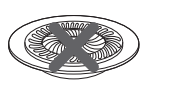
Using the Griddle
The non-stick coated griddle provides an extralarge cooking surface for meats, pancakes or other food usually prepared in a frying pan or skillet.
CAUTION: Avoid cooking extremely greasy foods as grease spillover can occur. The griddle can become hot when surrounding burners are in use. Do not overheat the griddle. This can damage the non stick coating. Do not use metal utensils that can damage the griddle surface. Do not use the griddle as a cutting board. Do not place or store items on the griddle.
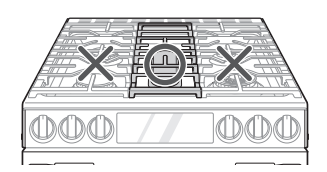
In Case of Power Failure
In case of a power failure, you can light the gas surface burners on your range with a match. Surface burners in use when an electrical power failure occurs will continue to operate normally.
CAUTION: Use extreme caution when lighting burners with a match. It can cause burns and other damage.
- Hold a lit match to the burner, then push in the control knob.
- Turn the control knob to the Lo position.
Oven
Before Using the Oven
- Because the oven temperature cycles, an oven thermometer placed in the oven cavity may not show the same temperature that is set on the oven.
- It is normal for the convection fan to run while preheating during a regular bake cycle.
- The convection fan motor may run periodically during a regular bake cycle.
- The heat turns off if the door is left open during baking. If the door is left open for longer than 30 seconds during baking, the heat turns off. The heat turns back on automatically once the door is closed.
- Avoid opening the oven door more than necessary during use. This helps the oven maintain temperature, prevents unnecessary heat loss, and saves on energy use.
- Do not operate the oven without the charcoal heater mesh.
Oven Vent
Areas near the vent may become hot during operation and may cause burns. Do not block the vent opening. Avoid placing plastics near the vent as heat may distort or melt the plastic.
It is normal for steam to be visible when cooking foods with high moisture content.

CAUTION: The edges of the range vent are sharp. Wear gloves when cleaning the range to avoid injury
Using Oven Racks - The racks have a turned-up back edge that prevents them from being pulled out of the oven cavity.
Removing Racks
- Pull the rack straight out until it stops.
- Lift up the front of the rack and pull it out.
Replacing Racks
- Place the end of the rack on the support.
- Tilt the front end up and push the rack in.
Instaview
Knock twice on the center of the glass panel to reveal the contents of the oven without opening the door.
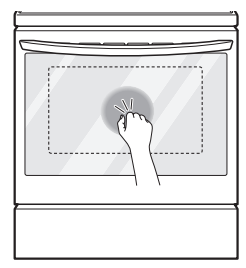
Bake - Bake is used to prepare foods such as pastries, breads and casseroles. The oven can be programmed to bake at any temperature from 170 ℉ (80 ℃) to 550 ℉ (285 ℃). The default temperature is 350 ℉ (175 ℃).
Setting the Bake Function (For example, to bake at 375 ℉)
- Turn the oven mode knob to select Bake.
- Set the oven temperature: Press 3, 7 and 5.
- Press START. The oven starts to preheat.
- When cooking is complete, turn the oven mode knob to the OFF position.
- Remove the food from the oven.
Baking Tips
- Baking time and temperature will vary depending on the characteristics, size, and shape of the baking pan used.
- Check for food doneness at the minimum recipe time.
- Use metal bakeware (with or without a nonstick finish), heatproof glass-ceramic, ceramic or other bakeware recommended for oven use.
- Dark metal pans or nonstick coatings will cook food faster with more browning. Insulated bakeware will slightly lengthen the cooking time for most foods.
- The oven bottom has a porcelain-enamel finish. To make cleaning easier, protect the oven bottom from excessive spillovers by placing a cookie sheet on the rack below the rack you are cooking on. This is particularly important when baking a fruit pie or other foods with a high acid content. Hot fruit fillings or other foods that are highly acidic may cause pitting and damage to the porcelain-enamel surface and should be wiped up immediately.
Convection Mode - The convection system uses a fan to circulate the heat evenly within the oven. Improved heat distribution allows for even cooking and excellent results while cooking with single or multiple racks.
Setting the Convection Function (For example, cooking at 375 °F)
- Turn the oven mode knob to select Conv. Bake or Conv. Roast. The display flashes 350 °F.
- Set the oven temperature: Press 3, 7 and 5.
- Press START. The display shows Conv. Bake or Conv. Roast and the oven temperature starting at 100 °F. As the oven preheats, the display shows increasing temperatures in 5-degree increments. Once the oven reaches the set adjusted temperature, a tone sounds and the oven light flashes on and off. The display shows the auto-converted oven temperature, 350 °F and the fan icon.
- When cooking has finished or to cancel, turn the oven mode knob to the OFF position.
Tips for Convection Baking
- Use Convection Bake for faster and more even multiple-rack cooking of pastries, cookies, muffins, biscuits, and breads of all kinds.
- Bake cookies and biscuits on pans with no sides or very low sides to allow heated air to circulate around the food. Food baked on pans with a dark finish will cook faster.
- When using Convection Bake, place the oven racks in positions suggested in the charts in this manual.
- Multiple oven rack cooking may slightly increase cook times for some foods.
- Cakes, cookies and muffins have better results when using multiple racks.
The Convection Roast feature is designed to give optimum roasting performance. Convection Roast combines cooking with the convection fan to roast meats and poultry. The heated air circulates around the food from all sides, sealing in juices and flavors. Foods are crispy brown on the outside while staying moist on the inside. Convection roasting is especially good for large tender cuts of meat, uncovered.
Tips for Convection Roasting - Use a broiler pan and grid when preparing meats for convection roasting. The broiler pan catches grease spills and the grid helps prevent grease splatters.
- Place the oven rack in the recommended position.
- Place the grid in the broiler pan.
- Place the broiler pan on the oven rack.

Recommended Baking and Roasting Guide
Baking results will be better if baking pans are centered in the oven as much as possible. If cooking on multiple racks, place the oven racks in the positions shown.
Multiple-rack cooking saves time and energy. Whenever possible, cook foods requiring the same cooking temperature together in one oven.
Rack and Pan Placement

Baking Rack Guide


Roasting Rack Guide
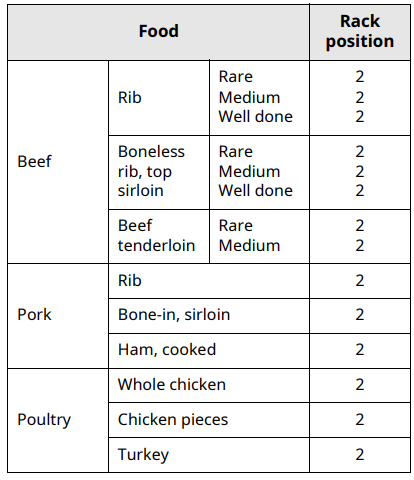
Broil
The Broil function uses intense heat from the upper heating element to cook food. Broiling works best for tender cuts of meat, fish, and thinly cut vegetables.
Some models may feature a hybrid broiler consisting of an inner broiler that utilizes a carbon heating element which provides instantaneous heat, and a traditional outer broiling element. During normal broiler operation, it is normal for either element to cycle off intermittently.
Setting the Oven to Broil
- Turn the oven mode knob to select Broil. Press 1 to set Hi or press 2 to set Lo.
- Press START. The oven begins to heat.
- Let the oven preheat for approximately five minutes before cooking the food if using Broil.
- Turn the oven mode knob to the OFF position to cancel at any time or when cooking is complete.
Tips for Reducing Smoke: Due to the intense heat associated with broiling, it is normal to experience smoke during the cooking process. This smoke is a natural byproduct of searing and should not cause you to worry. If you are experiencing more smoke than you are comfortable with, use the following tips to reduce the amount of smoke in your oven.
- Always use a broiler pan. Do not use saute pans or regular baking sheets for safety reasons.
- The broiler pan should always be thoroughly cleaned and at room temperature at the beginning of cooking.
- Always run your cooktop ventilation system or vent hood during broiling.
- Keep the interior of your oven as clean as possible. Leftover debris from prior meals can burn or catch fire.
- Avoid fatty marinades and sugary glazes. Both of these will increase the amount of smoke you experience. If you would like to use a glaze, apply it at the very end of cooking.
- If you are experiencing significant smoke with any food item, consider:
- Lowering the broiler to the Lo setting.
- Lowering the rack position to cook the food farther away from the broiler.
- Using the Hi broil setting to achieve the level of searing you desire, and then either switching to the Lo broil setting, or switching to the Bake function.
- As a rule, fattier cuts of meat and fish will produce more smoke than leaner items.
- Adhere to the guidelines in the Recommended Broiling Guide section whenever possible.
Recommended Broiling Guide
- The size, weight, thickness, starting temperature, and your preference of doneness will affect broiling times. This guide is based on meats at refrigerator temperature. For best results when broiling, use a pan designed for broiling.
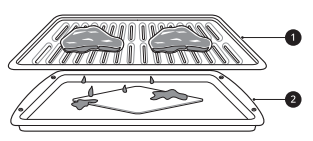
- Grid (sold separately)
- Broiler pan (sold separately)

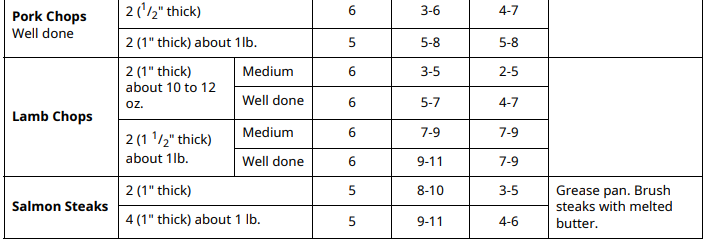
Tips for Broiling
- Beef
- Steaks and chops should always be allowed to rest for five minutes before being cut into and eaten. This allows the heat to distribute evenly through the food and creates a more tender and juicy result.
- Pieces of meat that are thicker than two inches should be removed from the refrigerator 30 minutes prior to cooking. This will help them cook more quickly and evenly, and will produce less smoke when broiling. Cooking times will likely be shorter than the times indicated in the Broiling Chart.
- For bone-in steaks or chops that have been frenched (all meat removed from around the bone), wrap the exposed sections of bone in foil to reduce burning.
- Seafood
- When broiling skin-on fish, always use the Lo broil setting and always broil the skin side last.
- Seafood is best consumed immediately after cooking. Allowing seafood to rest after cooking can cause the food to dry out.
- It is a good idea to rub a thin coating of oil on the surface of the broiling pan before cooking to reduce sticking, especially with fish and seafood. You can also use a light coating of non-stick pan spray.
- Vegetables
- Toss your vegetables lightly in oil before cooking to improve browning.
Proof - This feature maintains a warm oven for rising yeast-leavened products before baking. (Set temperature: 92 °F)
Setting the Proof Function

- Use rack position 2 or 3 for proofing.
- Turn the oven mode knob to select Proof/ Warm until Proof appears in the display.
- Press 1 to set Proof.
- Press START.
- Turn the oven mode knob to the OFF position when proofing is finished
Warm - This function maintains an oven temperature of 170 °F. It will keep cooked food warm for serving up to 3 hours after cooking has finished. The Warm function may be used without any other cooking operations or can be used after cooking has finished using a Timed Cook or a Delayed Timed Cook.
Setting the Warm Function
- Turn the oven mode knob to select Proof/ Warm until Proof appears in the display.
- Press 2 to set Warm.
- Press START.
- To cancel the Warm function, turn the oven mode knob to the OFF position.
Keep Warm - This function maintains an oven temperature of 170 °F. The Keep Warm function will keep cooked food warm for serving up to 3 hours after cooking has finished. The Keep Warm function should be used with any other cooking operations. The Keep Warm function can be used after cooking has finished using a Timed Cook or a Delayed Timed Cook.
Setting the Keep Warm Function after a Timed Cook
- Select the Bake, Conv. Bake, Conv. Roast, Air Fry, Slow Cook, or Frozen Meal cooking mode.
- Set the temperature.
- Press Cook Time and enter the cook time using the number buttons.
- Press Keep Warm.
- To cancel the Keep Warm function, turn the oven mode knob to the OFF position.
Air Fry - This feature automatically increases the entered temperature by 50°F for optimal performance when using Air Fry. The Air Fry function is specially designed for oilfree frying.
Setting the Air Fry Function
- Turn the oven mode knob to select Air Fry. 400°F appears in the display.
- Set the oven temperature. (Range: 300°F ~ 550°F)
- Press START.
- When cooking is complete, turn the oven mode knob to the OFF position.
Recommended Air Frying Guide
- Arrange food evenly in a single layer.
- Put a foil-lined baking pan on a rack in position 1 to catch drips. If needed, add parchment paper to absorb oil and reduce smoking.
- Flip food over during cooking to avoid burning it.
† High-fat items may produce more smoke when cooked using Air Fry. For less smoke, cook using Convection Roast mode.
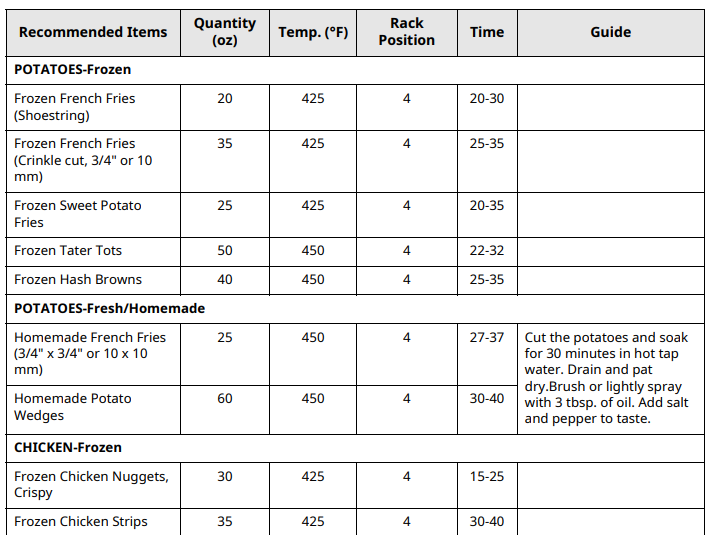
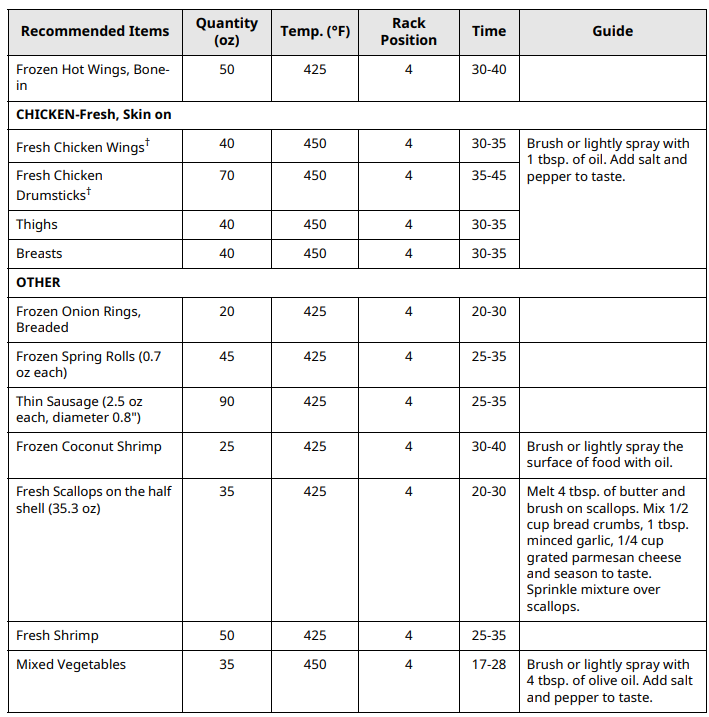
Air Sous-Vide
Air Sous-Vide cooking uses air to cook foods “low and slow.” Use it to cook meat, fish, seafood, poultry or vegetables. Food must be vacuum packed in pouches before cooking.
- It is not necessary to preheat the oven when using Air Sous-Vide.
- Refer to the cooking guide for recommended Air Sous-Vide settings.
Benefits of Air Sous-Vide: The lower temperatures and long cooking times used in Air Sous-Vide cooking provide many benefits.
- Healthier - Compared to other cooking methods, Air SousVide retains most of the original nutrients in food.
- Safe and Convenient - The long cooking times used in Air Sous-Vide cooking allow food to be pasteurized. Because food is vacuum packed before cooking, the unopened pouches can be quickly chilled in an ice bath and stored in the freezer or refrigerator after cooking.
- Crisp and Moist Results - The fine temperature control of Air Sous-Vide cooking is an excellent way to achieve the perfect texture when cooking meat and poultry. The low temperatures used retain more of the moisture in food than conventional cooking methods. After cooking, a final sear in a frying pan adds the perfect crisp finish.
Setting Air Sous-Vide Mode
- Place the heavy duty rack in position 3 and place the sealed food bag on it.
- Turn the oven mode knob to select Air SousVide mode.
- Set the desired oven temperature. (Range: 100 °F ~ 205 °F)
- Press START.
- Once cooking is finished, allow the oven to cool completely
Recommended Air Sous-Vide Guide

Frozen Meal - The Frozen Meal function is specially designed for cooking frozen prepared meals. It heats from both the top and bottom to brown food more evenly. This system is designed to give the optimum cooking performance by automatically selecting a combination of the broil and bake heating systems. No preheating is required when using the Frozen Meal mode. For best results with frozen pizza, cook food on a single rack placed in position 4 at 400 °F.
Setting the Frozen Meal Function
- Turn the oven mode knob to select Frozen Meal. Frozen appears in the display.
- Set the cook temperature using the number buttons.
- Press START. The Frozen Meal function starts operation. 4 When cooking is complete, turn the oven mode knob to the OFF position.
Remote Start - If the appliance is connected to a home Wi-Fi network, this function starts preheating and then holds the temperature for up to 12 hours (including preheating time). If the appliance is not connected to the network, OFF appears in the display. Follow the instructions in the Smart Functions section to connect the appliance to the network.
Setting Remote Start
- Open the oven door to make sure the oven is empty and ready for pre-heating. Close the oven door.
- Turn the oven mode knob to select Remote Start.
- When ON appears in the display, the Remote Start function is ready to use.
- Follow the directions in the smart phone application to set the cook mode, temperature, and run time (preheating time plus holding time).
Meat Probe - The meat probe accurately measures the internal temperature of meat, poultry and casseroles. It should not be used during broiling, self clean, warming, proofing, FrozenMeal or Air Sous-Vide. Always unplug and remove the meat probe from the oven when removing food. Before using, insert the probe into the center of the thickest part of the meat or into the inner thigh or breast of poultry, away from fat or bones. Place food in the oven and connect the meat probe to the jack. Keep the probe as far away from heat sources as possible.
Setting the Meat Probe Function (example for roast at 375 °F with probe temp. 160 °F)
- Insert the meat probe into the meat.

- Connect the meat probe to the jack.
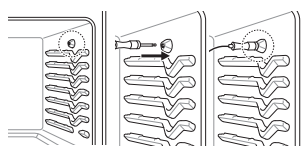
- The meat probe icon flashes in the display if the meat probe is properly connected.
Method
- Select cook mode. Turn the oven mode knob to select Conv. Roast.
- Set the oven temperature: touch 3, 7 and 5 until 375 °F appears in the display.
- Press Start.
- Set the probe temperature: touch 1, 6 and 0 until 160 °F appears in the display.
- Press Start
Changing the Probe Temperature
- Press Temp.
- Set the oven temperature.
- Press Start.
- Set the probe temperature.
- Press Start.
Using the Sabbath Mode - Sabbath mode is typically used on the Jewish Sabbath and Holidays. When the SABBATH mode is activated, the oven does not turn off until the SABBATH mode is deactivated. In SABBATH mode, all function buttons are inactive. sb will appear in the display.
- Disconnect the probe. The probe function is not available in Sabbath mode.
- Turn the oven mode knob to select Bake.
- Set the desired temperature and cook time.
- Press START.
- Press and hold Settings for three seconds. sb appears in the display when the Sabbath mode is activated.
- To stop the Sabbath mode, press and hold Settings for three seconds. To cancel the Bake function, set the oven mode knob to the OFF position at any time.
SMART FUNCTIONS
LG ThinQ Application Features
- Smart Diagnosis - This function provides useful information for diagnosing and solving issues with the appliance based on the pattern of use.
- Settings - Allows you to set various options on the oven and in the application.
- Scan to Cook - Scan the barcode on a ready-made meal using the LG ThinQ application and send the recommended or customized cooking instructions straight to your oven. Remote Start must be activated on the oven to use Scan to Cook.
- Monitoring - This function helps you check the current status, remaining time, cook settings and end time in one place.
- Product Notifications - Turn on the Push Alerts to receive appliance status notifications. The notifications are triggered even if the LG ThinQ application is not open.
- Timer - You can set the timer from the application.
- Firmware Update - Keep the appliance updated.
NOTE
- If you change your wireless router, Internet service provider, or password, delete the connected appliance from the LG ThinQ application and connect it again.
- This information is current at the time of publication. The application is subject to change for product improvement purposes without notice to users.
Before Using LG ThinQ Application
- Use a smartphone to check the strength of the wireless router (Wi-Fi network) near the appliance. If the appliance is too far from the wireless router, the signal becomes weak. It may take a long time to register or fail to install the application.
- Turn off the Mobile data or Cellular Data on your smartphone.

- Connect your smartphone to the wireless router.
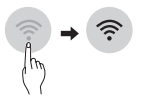
NOTE
- To verify the Wi-Fi connection, check that the
 icon on the control panel is lit.
icon on the control panel is lit. - The appliance supports 2.4 GHz Wi-Fi networks only. To check your network frequency, contact your Internet service provider or refer to your wireless router manual.
- LG ThinQ is not responsible for any network connection problems or any faults, malfunctions, or errors caused by network connection. ï The surrounding wireless environment can make the wireless network service run slowly.
- If the appliance is having trouble connecting to the Wi-Fi network, it may be too far from the router. Purchase a Wi-Fi repeater (range extender) to improve the Wi-Fi signal strength.
- The network connection may not work properly depending on the Internet service provider.
- The Wi-Fi may not connect or the connection may be interrupted because of the home network environment.
- If the appliance cannot be registered due to problems with the wireless signal transmission, unplug the appliance and wait about a minute before trying again.
- If the firewall on your wireless router is enabled, disable the firewall or add an exception to it.
- The wireless network name (SSID) should be a combination of English letters and numbers. (Do not use special characters.)
- Smartphone user interface (UI) may vary depending on the mobile operating system (OS) and the manufacturer.
- If the security protocol of the router is set to WEP, network setup may fail. Change the security protocol (WPA2 is recommended), and register the product again.
Installing the LG ThinQ Application
Search for the LG ThinQ application from the Google Play Store or Apple App Store on a smartphone. Follow instructions to download and install the application.
Connecting to Wi-Fi
The Wi-Fi button, when used with the LG ThinQ application, allows the appliance to connect to a home Wi-Fi network. The f icon shows the status of the appliance’s network connection. The icon illuminates when the appliance is connected to the Wi-Fi network.
- Initial Appliance Connection: Run the LG ThinQ application and follow the instructions in the application to connect the appliance.
- Reconnecting the Appliance or Connecting Another User: Press and hold the Wi-Fi button for 3 seconds. Run the LG ThinQ application and follow the instructions in the application to connect the appliance.
Wireless LAN Module Specifications
- Frequency Range: 2412 - 2462 MHz
- Output Power (Max): < 30 dBm
Open Source Software Notice Information
To obtain the source code under GPL, LGPL, MPL, and other open source licenses that have the obligations to disclose source code, that is contained in this product, and to access all referred license terms, copyright notices and other relevant documents please visit https:// opensource.lge.com.
LG Electronics will also provide open source code to you on CD-ROM for a charge covering the cost of performing such distribution (such as the cost of media, shipping, and handling) upon email request to [email protected].
This offer is valid to anyone in receipt of this information for a period of three years after our last shipment of this product.
Using Audible Diagnosis to Diagnose Issues
Follow the instructions below to use the audible diagnosis method. ï Launch the LG ThinQ application and select the Smart Diagnosis feature in the menu. Follow the instructions for audible diagnosis provided in the LG ThinQ application.
- Press the START button for three seconds. If the display has been locked, you must deactivate the lock and then reactivate it.
- Hold the mouthpiece of your phone in front of the Smart Diagnosis logo located on the control panel.

- Keep the phone in place until the tone transmission has finished. The display will count down the time. Once the countdown is over and the tones have stopped, the diagnosis will be displayed in the application.
MAINTENANCE
Cleaning
CAUTION
- Do not clean this appliance with bleach.
- To prevent burns, wait until the cooktop has cooled down before touching any of its parts.
- Always wear gloves when cleaning the cooktop.
General Cleaning Tips
- A plastic spatula can be used as a scraper to scrape off any chunks or debris before and during oven cleaning.
- Using the rough side of a non-scratch scouring pad may help to take off burnt-on stains better than a soft sponge or towel.
- Certain non-scratch scrubbing sponges, such as those made of melamine foam, available at your local stores, can also help improve cleaning.
Exterior
Control Panel - To prevent activating the control panel during cleaning, disconnect power to the appliance. Clean up splatters with a damp cloth using a glass cleaner. Remove heavier soil with warm, soapy water. Do not use abrasives of any kind.
Front Manifold Panel and Knobs - It is best to clean the manifold panel after each use of the range. For cleaning, use a damp cloth and mild soapy water or a 50/50 solution of vinegar and water. Rinse with clean water and polish dry with a soft cloth.
Painted and Decorative Trim - For general cleaning, use a cloth with hot soapy water. For more difficult soils and built-up grease, apply a liquid detergent directly onto the soil. Leave it on for 30 to 60 minutes. Rinse with a damp cloth and dry. Do not use abrasive cleaners.
Stainless Steel Surfaces - To avoid scratches, do not use steel wool pads.
- Place a small amount of stainless steel appliance cleaner or polish on a damp cloth or paper towel.
- Clean a small area, rubbing with the grain of the stainless steel if applicable.
- Dry and buff with a clean, dry paper towel or soft cloth.
- Repeat as necessary.
Oven Door - Do not use harsh cleaners or harsh abrasive cleaning materials on the outside of the oven door. Doing so can cause damage.
- Use soapy water to thoroughly clean the oven door. Rinse well. Do not immerse the door in water.
- You may use a glass cleaner on the outside glass of the oven door. Do not spray water or glass cleaner on the door vents.
- Do not use oven cleaners, cleaning powders, or harsh abrasive cleaning materials on the outside of the oven door.
- Do not clean the oven door gasket. The oven door gasket is made of a woven material that is essential for a good seal. Care should be taken not to rub, damage, or remove this gasket.

Broiler Pan and Grid

- Do not store a soiled broiler pan or grid anywhere in the range.
- Do not clean the broiler pan or grid in a self cleaning mode. (Available on some models)
- Remove the grid from the pan. Carefully pour out the grease from the pan into a proper container.
- Wash and rinse the broiler pan and grid in hot water with a soap-filled or plastic scouring pad.
- If food has burned on, sprinkle the grid with cleaner while hot and cover with wet paper towels or a dishcloth. Soaking the pan will remove burned-on foods.
- Both the broiler pan and grid may be cleaned with a commercial oven cleaner or in the dishwasher.
Oven Racks - Remove the oven racks before operating the Self Clean cycle (on some models) and EasyClean.
- Clean with a mild, abrasive cleaner. Food spilled into the tracks could cause the racks to become stuck.
- Rinse with clean water and dry
For models with Self Clean function: If the racks are cleaned using the Self Clean cycle (not recommended), the color will turn slightly blue and the finish will become dull. After the Self Clean cycle is complete, and the oven has cooled, rub the sides of the racks with wax paper or a cloth containing a small amount of oil. This will make the racks glide more easily into the rack tracks.
Vent Louvers
- The appearance of the range may differ from model to model. Use a vacuum cleaner with a brush or crevice attachment to clean the vent louvers 1. Do not remove the panel covering the range.

Gas Surface Burners
Removing and Replacing the Gas Surface Burners
- Position and size of burners vary by model.
- Grates and burner heads/caps can be removed for care and cleaning.

- Make sure burner heads and caps are reinstalled properly. They will be stable and rest flat when correctly installed.

- When burner cap is properly set:

- When burner cap is not properly set:

Cleaning Burner Heads/Caps - For even and unhampered flame, the slits in the burner heads must be kept clean at all times.The burner heads and caps (and the oval burner head and cap assembly) can be lifted off. Do not attempt to remove the oval burner cap.
- Wash the burner caps in hot soapy water and rinse with clean water. Run water through the oval burner from the bottom stem to flush out debris.
- Use care when cleaning the cooktop. The pointed metal ends on the electrodes could cause injury. Hitting an electrode with a hard object may damage it.
- To remove burnt-on food, soak the burner heads in a solution of mild liquid detergent and hot water for 20–30 minutes. For stubborn stains, use a toothbrush or wire brush.
- The burners will not operate properly if the burner ports or electrodes are clogged or dirty.
- Burner caps and heads should be cleaned routinely, especially after excessive spillover. ï Burners will not light if the cap is removed.
After Cleaning the Burner Heads/Caps
- Shake out any excess water and then let them dry thoroughly. Placing the oval burner upside down will allow the water to drain out more easily. Replace the burner heads and caps over the electrodes on the cooktop in the correct locations according to their size. Make sure the hole in the burner head is positioned over the electrode.
Burner Grates
- The range consists of three separate professionalstyle grates. For maximum stability, these grates should only be used when in their proper position. The center grate can be rotated from front to back.

Cleaning the Burner Grates
- Do not lift the grates out until they have cooled.
- Do not put the grate in the oven during self cleaning mode. (On some models)
- Grates should be washed regularly and after spillovers.
- Wash the grates in hot, soapy water and rinse with clean water.
- The grates are dishwasher safe.
- After cleaning the grates, let them dry completely and securely position them over the burners.
Cleaning the Cooktop Surface - The EasyClean coating makes cleaning the cooktop easier. Even heavy grease stains can be removed using only warm water. Foods with high acid or sugar content may cause a dull spot if allowed to set. Wash and rinse soon after the surface has cooled. For other spills such as oil/grease spattering, wash with soap and water when the surface has cooled, then rinse and polish with a dry cloth.
- Remove grates, burners and burner caps from the cooktop.
- Scrape off and remove any burned-on debris with a plastic scraper or old credit card.
- Clean the cooktop with a wet, non-scratch scouring sponge or pad.
EasyClean
LG’s EasyClean enamel technology provides two cleaning options for the inside of the range. The EasyClean feature takes advantage of LG’s new enamel to help lift soils without harsh chemicals, and it runs using ONLY WATER for just 10 minutes in low temperatures to help loosen LIGHT soils before hand cleaning.
While EasyClean is quick and effective for small and LIGHT soils, the Self Clean feature can be used to remove HEAVY, built up soils. The intensity and high heat of the Self Clean cycle may result in smoke which will require the opening up of windows to provide ventilation. Compared to the more intense Self Clean process, your LG oven gives you the option of cleaning with LESS HEAT, LESS TIME, and virtually NO SMOKE OR FUMES. You can reduce energy use by cleaning light oven soils with the EasyClean feature instead of Self Clean.
When needed, the range still provides the Self Clean option for longer, more thorough oven cleaning for heavier, built up soils.
- For hard to reach areas such as the back surface of the oven, it is better to use the Self Clean cycle.
Benefits of EasyClean
- Helps loosen light soils before hand-cleaning
- EasyClean only uses water; no chemical cleaners
- Makes for a better Self Clean experience
- Delays the need for a Self Clean cycle
- Minimizes smoke and odors
- Can allow shorter Self Clean time
When to Use EasyClean - Example of oven soiling

Case 1
- Soil pattern: Small drops or spots
- Types of soils: Cheese or other ingredients
- Common food items that can soil your oven: Pizza
Case 2
- Soil pattern: Light splatter
- ypes of soils: Fat/grease
- Common food items that can soil your oven: Steaks, broiled / Fish, broiled / Meat roasted at low temperatures
EasyClean Instruction Guide
1. Remove oven racks and accessories from the oven.
2. Scrape off and remove any burnt-on debris with a plastic scraper.

Suggested plastic scrapers:
- Hard plastic spatula
- Plastic pan scraper
- Plastic paint scraper
- Old credit card
3. Fill a spray bottle (10 oz or 300 ml) with water and use the spray bottle to thoroughly spray the inside surfaces of the oven.
4. Use at least 1/5 (2 oz or 60 ml) of the water in the bottle to completely saturate the soil on both the walls and in the corners of the oven.

5. Spray or pour the remaining water (8 oz or 240 ml) onto the bottom center of the oven cavity. The indentation on the oven bottom
6. Close the oven door. Turn the oven mode knob to select EasyClean. Press START.
7. A tone will sound at the end of the 10 minute cycle. Turn the oven mode knob to the OFF position to clear the display and end the tone.
8. After the cleaning cycle and during handcleaning, enough water should remain on the oven bottom to completely submerge all soils. Add water if necessary. Place a towel on the floor in front of the oven to capture any water that may spill out during hand-cleaning.
9. Clean the oven cavity immediately after the EasyClean cycle by scrubbing with a wet, nonscratch scouring sponge or pad. (The scouring side will not scratch the finish.) Some water may spill into the bottom vents while cleaning, but it will be captured in a pan under the oven cavity and will not hurt the burner.

10. Once the oven cavity is cleaned, wipe any excess water with a clean dry towel. Replace racks and any other accessories.
11. If some light soils remain, repeat the above steps, making sure to thoroughly soak the soiled areas. For models with Self Clean function: If stubborn soils remain after multiple EasyClean cycles, run the Self Clean cycle. Be sure that the oven cavity is empty of oven racks and other accessories, and that the oven cavity surface is dry before running the Self Clean cycle. Consult the Self Clean section of your owner’s manualfor further details. If a Self Clean option is not available, scrape off and remove stubborn soil using a scraper.
Self Clean
The Self Clean cycle uses extremely hot temperatures to clean the oven cavity. While running the Self Clean cycle, you may notice smoking or an odor. This is normal, especially if the oven is heavily soiled. During Self Clean, the kitchen should be well ventilated to minimize the odors from cleaning.
Before Starting Self Clean
- Clean only parts listed in manual. Remove the oven racks, broiler pan, broiler grid, all cookware, aluminum foil or any other material from the oven. If oven racks are left in the oven cavity during the Self Clean cycle, they will discolor and become difficult to slide in and out.
- The kitchen should be well ventilated to minimize the odors from cleaning. Open a window or turn on a ventilation fan or hood before self-cleaning.
- Wipe any heavy spillovers on the bottom of the oven.
- Make sure that the oven light cover is in place and the oven light is off.
- Clean the frame of the oven and door with hot soapy water. Rinse well.
When to Use Self Clean - Example of oven soiling
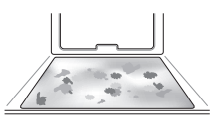
Case 1
- Soil pattern: Medium to heavy splatter
- Types of soils: Fat/grease
- Common food items that can soil your oven: Meat roasted at high temperatures
Case 2
- Soil pattern: Drops or spots
- Types of soils: Filling or sugar based soils
- Common food items that can soil your oven: Pies
Case 3
- Soil pattern: Drops or spots
- Types of soils: Cream or tomato sauce
- Common food items that can soil your oven: Casseroles
Setting Self Clean
The Self Clean function has cycle times of 3, 4, or 5 hours.
Self Clean Soil Guide
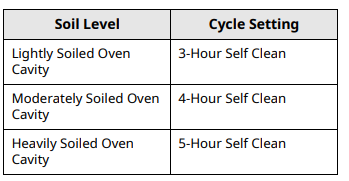
- Remove all racks and accessories from the oven.
- Turn the oven mode knob to select Self Clean. The oven defaults to the recommended fourhour Self Clean for a moderately soiled oven. Press buttons as below to select a self clean time from 3 to 5 hours.
- 3 hours
- 4 hours
- 5 hours
- Press START.
- Once the Self Clean cycle is set, the oven door locks automatically and the lock icon k displays. You will not be able to open the oven door until the oven has cooled. The lock releases automatically when the oven has cooled.
Setting Self Clean with a Delayed Start
- Remove all racks and accessories from the oven.
- Turn the oven mode knob to select Self Clean. The oven defaults to the recommended fourhour self clean for a moderately soiled oven. Press buttons as below to select a self clean time from 3 to 5 hours.
- 3 hours
- 4 hours
- 5 hours
- Press Start Time.
- Set the time of day you would like the Self Clean to start by pressing numbers.
- Press START.
Removing/Assembling Lift-Off Oven Doors
Door Care Instructions - Most oven doors contain glass that can break.
- Do not close the oven door until all the oven racks are fully in place.
- Do not hit the glass with pots, pans, or any other object.
- Scratching, hitting, jarring, or stressing the glass may weaken its structure causing an increased risk of breakage at a later time.
Removing Doors
- Fully open the door.
- Unlock the hinge locks, rotating them as far toward the open door frame as they will go.
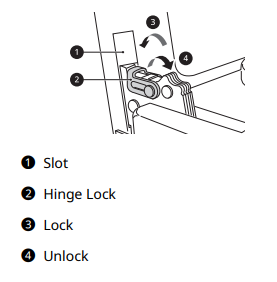
- Firmly grasp both sides of the door at the top.
- Close the door to the removal position (approximately five degrees) which is halfway between the broil stop position and fully closed. If the position is correct, the hinge arms will move freely.
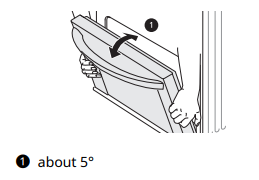
- Lift door up and out until the hinge arms are clear of the slots.
Assembling Doors
- Firmly grasp both sides of the door at the top.
- With the door at the same angle as the removal position, seat the indentation of the hinge arms into the bottom edge of the hinge slots. The notch in the hinge arms must be fully seated into the bottom edge of the slots.

- Open the door fully. If the door will not open fully, the indentation is not seated correctly in the bottom edge of the slots.
- Lock the hinge locks, rotating them back toward the slots in the oven frame until they lock.
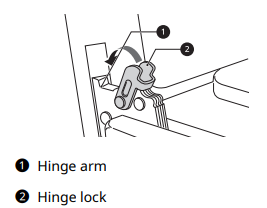
- Close the oven door.
Removing/Assembling Drawers
Removing Drawers - Most cleaning can be done with the drawer in place; however, the drawer may be removed if further cleaning is needed. Use warm water to thoroughly clean.
- Fully open the drawer.
- Unscrew the screw 1 on the back of the drawer.

- Locate the glide lever on each side of the drawer. Push down on the left glide lever and pull up on the right glide lever.
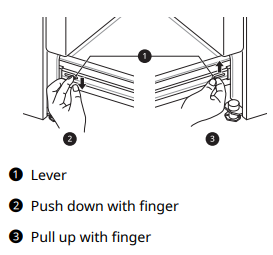
- Pull the drawer away from the range.
Assembling Drawers
- Pull the bearing glides to the front of the chassis glide.
- Align the glide on each side of the drawer with the glide slots on the range.
- Push the drawer into the range until levers click (approximately 2 inches).
- Insert and tighten the screws on the back of the drawer.
- Pull the drawer open again to seat the bearing glides into position.
Removing/Assembling the Vent Trim
Removing the Vent Trim
- Using a screwdriver, remove the two screws holding the vent trim in place.
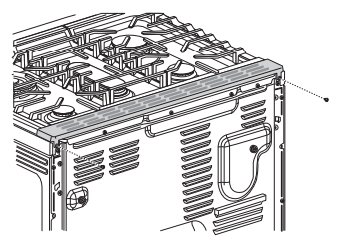
- Move the vent trim in the indicated direction approximately 1/4".

- Lift the vent trim.

Assembling the Vent Trim
Assemble the vent trim in the reverse sequence of its removal.
Periodic Maintenance
Changing the Oven Light
The oven light is a standard 40-watt appliance halogen lamp. It turns on when the oven door is open. When the oven door is closed, press Light to turn it on or off.
WARNING
- Make sure that the oven and lamp are cool.
- Disconnect the electrical power to the range at the main fuse or circuit breaker panel. Failure to do so can result in severe personal injury, death, or electrical shock
- Unplug the range or disconnect power.
- Turn the glass lamp cover in the back of the oven counterclockwise to remove.
- Remove the halogen lamp from the socket.
- Insert the new halogen lamp.
- Insert the glass lamp cover and turn it clockwise.
- Plug in the range or reconnect the power.

TROUBLESHOOTING
FAQs - Frequently Asked Questions
What types of cookware are recommended for use with the cooktop?
- The pans must have a flat bottom and straight sides.
- Only use heavy-gauge pans.
- The pan size must match the amount of food to be prepared and the size of the surface element.
- Use tight fitting lids.
- Only use flat-bottom woks.
Why do the heating elements appear to be turning ON and OFF during use of the cooktop or oven?
Depending on your cooktop element setting or the temperature selected in your oven it is NORMAL for the cooking elements to cycle on and off.
My new oven doesn’t cook like my old one. Is there something wrong with the temperature settings?
No. Your oven has been factory tested and calibrated. For the first few uses, follow your recipe times and temperatures carefully. If you still think your new oven is too hot or too cold, you can adjust the oven temperature yourself to meet your specific cooking needs. Refer to the Changing Oven Settings section in this manual for easy instructions on how to adjust your thermostat.
Is it normal to hear a clicking noise coming from the back of my oven when I am using it?
Your new range is designed to maintain a tighter control over your oven’s temperature. You may hear your oven’s heating elements click on and off more frequently on your new oven. This is NORMAL.
Why is the time flashing?
This means that the product has just been plugged in, or that it has experienced a power interruption. To clear the flashing time, touch any button and reset the clock if needed.
During convection cooking the fan stops when I open the door. Is that normal?
Yes, this is normal. When the door is opened, the convection fan will stop until the door is closed.
Can I use aluminum foil to catch drippings in my oven cavity?
Never use aluminum foil to line the bottom or sides of the oven or the warming drawer (on some models). The foil will melt and stick to the bottom surface of the oven and will not be removable. Use a foil-lined sheet pan placed on a lower oven rack to catch drippings instead. (If foil has already melted onto the bottom of the oven, it will not interfere with the oven’s performance.)
Can I use aluminum foil on the racks?
Do not cover racks with aluminum foil. Covering entire racks with foil restricts air flow, leading to poor cooking results. Use a sheet pan lined with foil under fruit pies or other acidic or sugary foods to prevent spillovers from damaging the oven finish.
Can I leave my racks in the oven when running a Self Clean cycle? (On some models)
No. Although it will not damage the racks, it will discolor them and may make them hard to slide in and out during use. Remove all items from the oven before starting a Self Clean cycle.
What should I do if my racks are sticky and have become hard to slide in and out?
Over time, the racks may become hard to slide in and out. Apply a small amount of olive oil to the sides of the racks. This will work as a lubricant for easier gliding.
What should I do for hard to remove stains on my cooktop?
The cooktop should be cleaned after every use to prevent permanent staining. When cooking foods with high sugar content, such as tomato sauce, clean the stain off with a scraper while the cooktop is still warm. Use an oven mitt when scraping to prevent burns. Refer to the MAINTENANCE section of this owner's manual for further instruction.
Why aren't the function buttons working?
Make sure that the range is not in Control Lock / Lockout mode. The lock k will show in the display if Control Lock / Lockout is activated. To deactivate Control Lock / Lockout, refer to the Control Lock / Lockout section. The unlock melody sounds and Loc appears in the display until the controls are unlocked.
My range is still dirty after running the EasyClean cycle. What else should I do?
The EasyClean cycle only helps to loosen light soils in your oven range to assist in hand-cleaning of your oven. It does not automatically remove all soils after the cycle. Some scrubbing of your oven range is required after running the EasyClean cycle.
I tried scrubbing my oven after running EasyClean, but some soils still remain. What can I do?
The EasyClean feature works best when the soils are fully soaked and submerged in water before running the cycle and during hand-cleaning. If soils are not sufficiently soaked in water, it can negatively affect the cleaning performance. Repeat the EasyClean process using sufficient water.
- For models with Self Clean function: Sugar-based and certain greasy soils are especially hard to clean. If some stubborn soils remain, use the Self Clean feature to thoroughly clean your oven.
Soils on my oven walls are not coming off. How can I get the oven walls clean?
Soils on the side and rear walls of your oven range may be more difficult to fully soak with water. Try repeating the EasyClean process with more than the ¼ cup (2 oz or 60 ml) of spray recommended.
Will EasyClean get all of the soils and stains out completely?
It depends on the soil type. Sugar-based and certain grease stains are especially hard to clean. Also, if stains are not sufficiently soaked in water, this can negatively affect cleaning performance. ï For models with Self Clean function: If stubborn or built-up stains remain, use the Self Clean feature. Refer to the Self Clean section of your owner's manual.
Are there any tricks to getting some of the stubborn soils out?
Scraping the soils with a plastic scraper before and during hand-cleaning is recommended. Fully saturating soils with water is also recommended.
- For models with Self Clean function: Certain types of soils are harder to clean than others. For these stubborn soils, the Self Clean cycle is recommended. Consult the Self Clean section of your owner's manual for details.
Is it safe for my convection fan or heater element to get wet during EasyClean?
Yes. The convection fan or heater element may get a little wet during cleaning. However, direct spray onto the broil burner and heater elements is not necessary because these are self-cleaning during regular use.
Do I need to use all 1 ¼ cups (10 oz or 300 ml) of water for EasyClean?
Yes. It is highly recommended that 1 cup (8 oz or 240 ml) of water be sprayed or poured on the bottom and an additional ¼ cup (2 oz or 60 ml) of water be sprayed on walls and other soiled areas to fully saturate the soils for better cleaning performance.
I see smoke coming out of my oven range’s cooktop vents during EasyClean. Is this normal?
This is normal. This is not smoke. It is actually water vapor (steam) from the water in the oven cavity. As the oven heats briefly during EasyClean, the water in the cavity evaporates and escapes through the oven vents.
How often should I use EasyClean?
EasyClean can be performed as often as you wish. EasyClean works best when your oven is LIGHTLY soiled from such things as LIGHT grease splatter and small drops of cheese. Please refer to the EasyClean section in your owner's manual for more information.
What is required for EasyClean?
A spray bottle filled with 1¼ cups (10 oz or 300 ml) of water, a plastic scraper, a non-scratch scrubbing pad and a towel. You should not use abrasive scrubbers such as heavy-duty scouring pads or steel wool. Except for a towel, all of the materials you need are included in a special cleaning kit with your new range.
Can I run the EasyClean cycle on both of my ovens at once?
Yes. You can run the EasyClean cycle on both ovens at the same time. Some oven surfaces will be hot after the cycle completes running. Avoid leaning or resting on the oven door glass while cleaning the oven cavities. You cannot run the Self Clean cycle on both ovens at the same time.
Before Calling for Service
Cooking
Top burners do not light or do not burn evenly.
- The electrical plug is not inserted properly.
- Make sure that the electrical plug is inserted into a live, properly grounded outlet.
- Electrode area is not clean.
- Remove the burners and clean them. Check the electrode area for burnt on food or grease. See "Cleaning Burner Heads/Caps" in the MAINTENANCE chapter.
- Burner parts are not installed properly.
- Make sure that the burner parts are installed correctly. See "Removing and Replacing the Gas Surface Burners" in the MAINTENANCE chapter.
Burners are not lighting properly after cleaning the cooktop surface.
- Burner heads and caps are not completely dry or properly positioned.
- Make sure that the burner heads and caps are completely dry and properly positioned.
Burner flames are very large or yellow.
- It may be due to improper installation or setting.
- If the range is connected to LP gas, contact the technician who installed your range or made the conversion.
Surface burners light but the oven does not.
- Shut-off valve is not fully open.
- Make sure that the oven gas shut-off valve, located behind the range, is fully open.
Food does not bake or roast properly
- Oven controls improperly set.
- See the "Oven" section in the Operation chapter.
- Rack position is incorrect or the rack is not level.
- See the "Oven" section in the Operation chapter.
- Incorrect cookware or cookware of improper size being used.
- See the "Oven" section in the Operation chapter.
- Oven thermostat needs to be adjusted.
- See the "Adjusting the Oven Thermostat" section in the Operation chapter.
- The Clock is not set correctly.
- See "Changing Oven Settings" in the OPERATION chapter.
- Aluminum foil used improperly in the oven.
- See "Using Oven Racks" in Oven section.
Food does not broil properly
- Oven controls improperly set.
- Make sure you select the Broil mode properly.
- Improper rack position being used.
- See the Broiling Guide.
- Cookware not suited for broiling.
- Use broiling pan and grid.
- The oven door is not closed.
- See "Broil" in the OPERATION chapter.
- Aluminum foil used on the broiling pan and grid has not been fitted properly and slit as recommended.
- See the "Oven" section in the Operation chapter.
- In some areas the power voltage may be low.
- Preheat the broil element for 5-7 minutes.
- See the Broiling Guide.
Oven temperature too hot or too cold
- Oven sensor needs to be adjusted.
- See the "Adjusting the Oven Thermostat" section in the Operation chapter.
Excessive smoking during a Self Clean cycle (On some models)
- Excessive soil.
- Turn off the Self Clean function. Open the windows to rid the room of smoke. Wait until the Self Clean mode is cancelled. Wipe up the excess soil and reset the clean.
Burning or oily odor emitting from the vent
- This is normal in a new oven.
- This will disappear in time. To speed the process, set a Self Clean cycle for a minimum of See the Self Clean section. (On some models)
Oven will not work
- Plug on range is not completely inserted in the electrical outlet.
- Make sure electrical plug is plugged into a live, properly grounded outlet.
- A fuse in your home may be blown or the circuit breaker tripped.
- Replace the fuse or reset the circuit breaker.
- Oven controls improperly set.
- See the "Oven" section in the Operation chapter.
- Oven too hot.
- Allow the oven to cool to below locking temperature.
Steam is exhausted through the oven vent.
- Cooking foods with high moisture produces steam.
- This is normal.
Appliance does not operate.
- Cord is not plugged in correctly.
- Make sure cord is plugged correctly into outlet. Check circuit breakers.
- Service wiring is not complete.
- Contact your electrician for assistance.
- Power outage.
- Check house lights to be sure. Call your local electric company for service.
Oven smokes excessively during broiling.
- Control not set properly.
- Follow instructions under Setting Oven Controls.
- Meat too close to the element.
- Reposition the rack to provide proper clearance between the meat and the element. Preheat broil element for searing.
- Meat not properly prepared.
- Remove excess fat from meat. Cut remaining fatty edges to prevent curling.
- Insert on broiler pan wrong side up and grease not draining.
- Always place the grid on the broiler pan with ribs up and slots down to allow grease to drip into the pan.
- Grease has built up on oven surfaces. Old grease or food spatters cause excessive smoking.
- Regular cleaning is necessary when broiling frequently.
Moisture collects on oven window or steam comes from oven vent
- This happens when cooking foods high in moisture.
- This is normal.
- Excessive moisture was used when cleaning the window.
- Do not use excessive moisture when cleaning the window.
Parts & Features
Range is not level.
- Poor installation.
- Place oven rack in center of oven. Place a level on the oven rack. Adjust leveling legs at
- base of range until the oven rack is level.
- Be sure floor is level and strong and stable enough to adequately support range.
- If floor is sagging or sloping, contact a carpenter to correct the situation.
- Kitchen cabinet alignment may make range appear unlevel.
- Be sure cabinets are square and have sufficient room for range clearance.
Cannot move appliance easily. Appliance must be accessible for service.
- Cabinets not square or are built in too tightly.
- Contact builder or installer to make appliance accessible.
- Carpet interferes with range.
- Provide sufficient space so range can be lifted over carpet.
- Anti-tip device engaged.
- Uninstall the anti-tip device to move the range. Reengage the anti-tip device after pulling the range out for cleaning, service, or any other reason.
Oven control beeps and displays any F code error.
- Electronic control has detected a fault condition.
- Turn off the oven function you are using to clear the display and stop beeping. Reprogram oven. If fault recurs, record fault number and contact a service agent.
Displayed colon in the clock is flashing
- This means that the product has just been plugged in, or that it has experienced a power interruption.
- This is normal. Reset the clock or press any button to stop the flashing.
CLEAN and door flash in the display (On some models)
- The Self Clean cycle has been selected, but the door is not closed.
- Close the oven door.
Loc is on in the display when you want to cook (On some models)
- The oven is locked because of the Control Lock / Lockout feature.
- Deactivate the Control Lock / Lockout feature.
- The oven door is locked because the temperature inside the oven has not dropped below the locking temperature.
- Allow the oven to cool.
Oven light does not work.
- It is time to replace the lamp/bulb or it is loose.
- Replace or tighten lamp/bulb. See "Changing the Oven Light" section in this Owner’s Manual.
Convection fan stops. (During Conv.Bake mode)
- Convection fan stops during a convection bake cycle. It is done to allow for more even heating during the cycle.
- This is not a failure of the range and should be considered normal operation.
Oven will not Self Clean. (On some models)
- The oven temperature is too high to set a Self Clean operation.
- Allow the range to cool and reset the controls.
- Oven controls improperly set.
- See the Self Clean section.
- A Self Clean cycle cannot be started if the oven Control Lock / Lockout feature is active.
- See the "Control Lock / Lockout" in "Changing Oven Settings" section.
Noises
- “Crackling” or “popping” sound
- This is the sound of the metal heating and cooling during both the cooking and Self Clean functions. This is normal
- Fan noise
- A convection fan may automatically turn on and off. This is normal
Wi-Fi
Trouble connecting appliance and smartphone to Wi-Fi network
- The password for the Wi-Fi network was entered incorrectly.
- Delete your home Wi-Fi network and begin the registration process again.
- Mobile data for your smartphone is turned on.
- Turn off the Mobile data on your smartphone before registering the appliance.
- The wireless network name (SSID) is set incorrectly.
- The wireless network name (SSID) should be a combination of English letters and numbers. (Do not use special characters.)
- The router frequency is not 2.4 GHz.
- Only a 2.4 GHz router frequency is supported. Set the wireless router to 2.4 GHz and connect the appliance to the wireless router. To check the router frequency, check with your Internet service provider or the router manufacturer.
- The distance between the appliance and the router is too far.
- If the appliance is too far from the router, the signal may be weak and the connection may not be configured correctly. Move the router closer to the appliance or purchase and install a Wi-Fi repeater.
